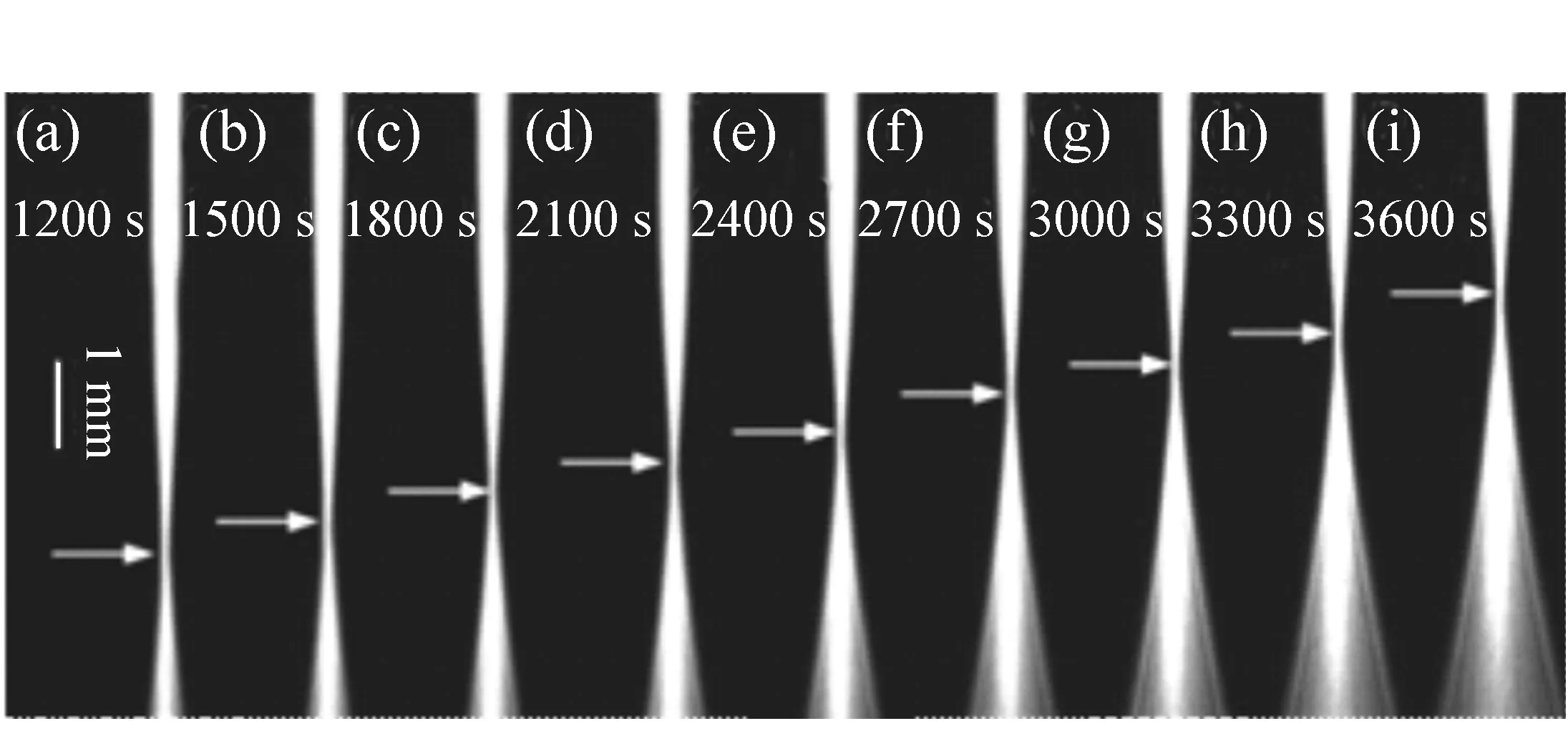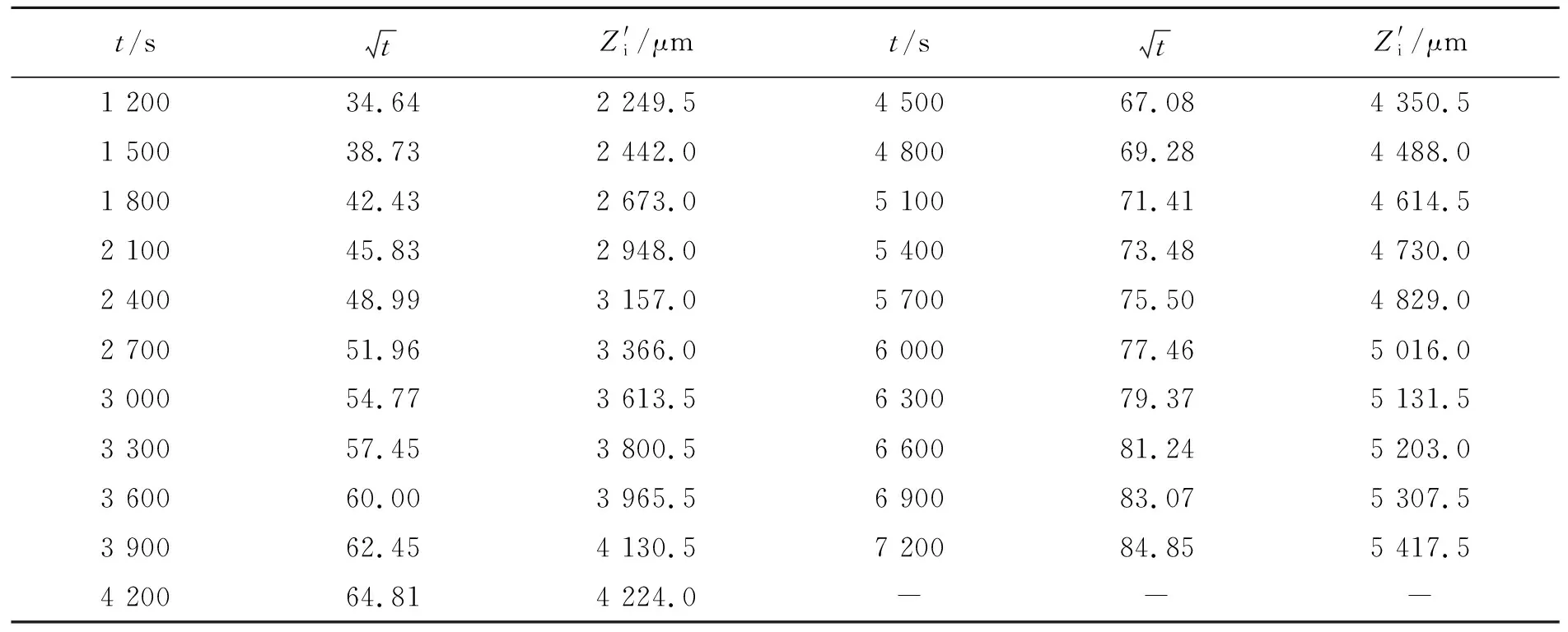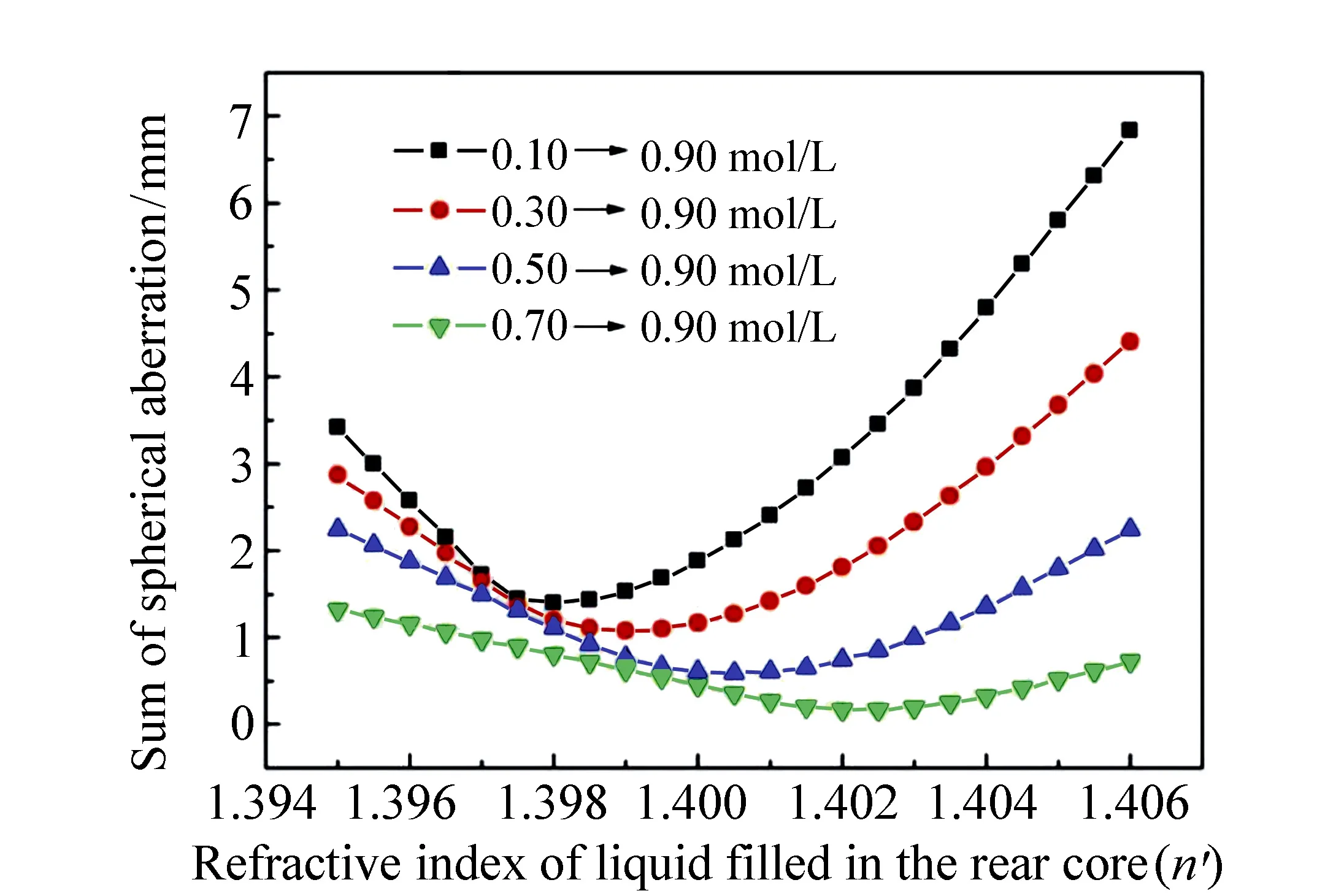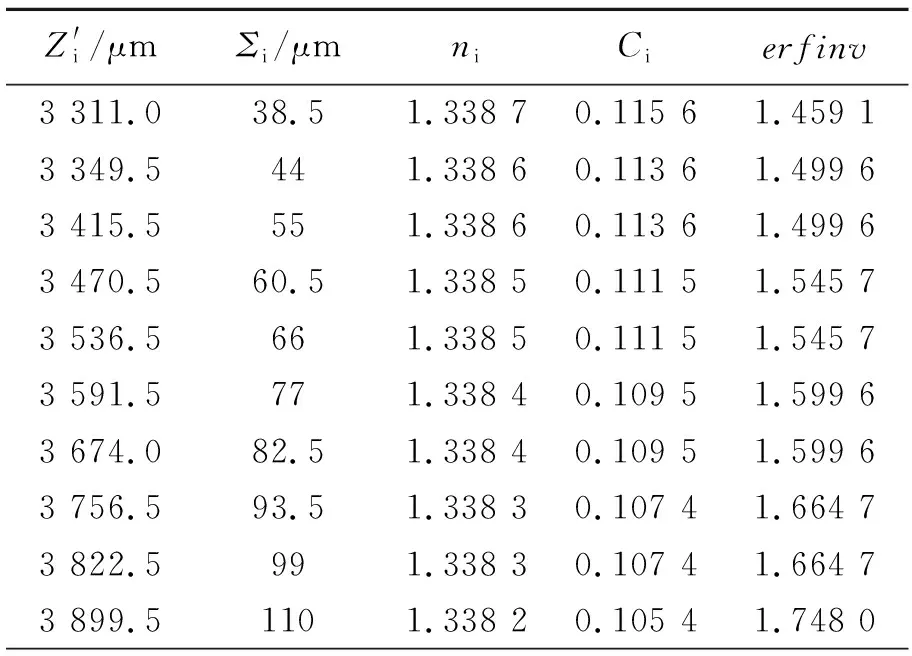Measuring liquid-phase diffusion coefficient of aqueous sucrose solution using double liquid-core cylindrical lens
SONG Fang-xi, MENG Wei-dong,3, XIA Yan, CHEN Yan, PU Xiao-yun,2*
(1.Department of Physics and Astronomy,Yunnan University,Kunming 650091,China;2.International Joint Research Center for Photoelectronics Energy Materials,>Yunnan University,Kunming 650091,China;3.Key Laboratory of Quantum Information of Yunnan Province,Kunming 650091,China)
Abstract: Based on the consideration of the high resolution of the spatial resolution of the refractive index of the double liquid-core cylindrical lens(DLCL), the liquid-phase diffusion coefficients of different concentrations of aqueous sucrose solution are measured at room temperature(25 ℃) using two methods. Method 1:equivalent RI(refractive index) method is used to calculate the liquid phase diffusion coefficient by recording the time-dependent change of a specific refractive index layer during diffusion. Method 2:instantaneous diffusion analytical method is used to determine the liquid diffusion coefficient by reading the relationship between image width and diffusion position in an instantaneous diffusion image. The front liquid core of the DLCL serves as a diffusion cell and a main imaging element, and the rear liquid core serves as an aplanatic auxiliary system. The spherical aberration at a particular thin liquid layer can be reduced as needed with a DLCL, and the spherical aberration advantage within a certain range of refractive index can also be reduced. Both methods have the characteristics of high measurement accuracy. The relative errors between the measured results and the literature values of the two methods are less than 1.3% and 3.9%, respectively, indicating that the measurement system is stable and reliable and the measurement results are accurate when the liquid-phase diffusion coefficient is measured with a DLCL.
Key words: double liquid-core cylindrical lens;diffusion coefficient;diffusion imaging;spherical aberration;refractive index
1 Introduction
引 言
The diffusion coefficient is an important basic data for the study of mass transfer process, calculation of mass transfer rate, and chemical design and development. It is widely used in fields of chemical, pharmaceutical, food, biological and environmental protection fields[1-4]. Since the average distance between liquid molecules is much smaller than that of gas molecules, and the liquid molecules do not have regular arrangments like solids, the theoretical description and experimental measurement of the liquid phase diffusion coefficient are far more difficult than gas and solids. The liquid phase diffusion data of different systems is quite lacking[5-6]. At present, the liquid phase diffusion coefficient is mainly obtained by experimental methods. By measuring the concentration-dependent spatial and temporal distribution of the solution due to the diffusion process, the liquid phase diffusion coefficient is calculated according to Fick′s law[7]for describing the diffusion process. From the experimental method to measure the diffusion coefficient, the diaphragm pool method[8], optical interference method[9]and Taylor dispersion method[10]are widely used. In addition, measurement methods such as nuclear magnetic resonance[11], dynamic light scattering[12], fluorescent molecular tracing[13]and radioactive element tracing[14]can also be used. Diaphragm cell method[8]is a classical steady-state measurement method. This method measures the initial and steady state solution concentrations in the upper and lower parts of the diffusion cell, so the measurement time is longer.Optical interference method[9]measures interference fringes formed when target light and reference light meet in space, and inverts the spatial and temporal distribution information of diffusion solution concentration carried by the target light through fringes. The measurement accuracy of this method is high, but its requirements for the experimental environment are extremely demanding. The Taylor dispersion method[10]is to inject trace solute into the solvent flowing in the capillary. The solute diffuses in the solvent to form a Gaussian distribution of the solution concentration along the capillary axis. The diffusion coefficient is calculated by measuring the concentration distribution curves at different times. The method is fast, but the measurement accuracy is low. The NMR method[11]has the characteristics of anti-interference, fast speed,etc., but it is only suitable for measuring some special substances. The dynamic light scattering method[12]is suitable for the measurement of the diffusion coefficient of a polymer solution. There are other methods such as fluorescent molecular tracing[13]and radioactive element tracing[14]. However, they are not widely used. In order to solve these problems, according to the imaging principle of the liquid-core cylindrical lens focal plane, we proposed the equivalent RI(refractive index) method[15-16]and the instantaneous diffusion image analytical method[16-17]to measure the liquid-phase diffusion coefficient by analyzing the diffusion image. Spherical aberration is the main factor influencing the imaging quality of diffused images. The ability of the DLCL[18]to reduce the spherical aberration improves the imaging quality of the diffused image,and it is the key to accurately measure the liquid-phase diffusion coefficient. The front liquid core of the DLCL serves as a diffusion cell and the main imaging element, and the rear liquid core serves as an aplanatic auxiliary system[19-20]. In this paper, DLCL is used to reduce the spherical aberration at certain thin liquid layers as needed, and it can reduce the advantage of spherical aberration within a certain refractive index range. In this paper, the diffusion coefficients of different concentrations of aqueous sucrose solution at room temperature(25 ℃) are measured by combining the above two methods.
扩散系数是研究传质过程、计算传质速率及化工设计与开发的重要基础数据,广泛应用于化工、医药、食品、生物及环保等领域[1-4]。由于液体分子的平均间距远比气体分子小, 又不及固体那样有规则排列, 所以液相扩散系数的理论描述和实验测量远比气体及固体困难, 不同体系的液相扩散数据相当缺乏[5-6]。目前,液相扩散系数主要依靠实验方法获得,通过测量溶液由于扩散过程形成的浓度随空间和时间的分布,根据描述扩散过程的Fick定律[7]计算出液相扩散系数。从测量扩散系数的实验方法来看,广泛采用的是膜池法[8]、光干涉法[9]和泰勒分散法[10]。此外,还有核磁共振[11]、动态光散射[12]、荧光分子示踪[13]和放射性元素示踪[14]等测量方法。膜池法[8]是一种经典的稳态测量法,需要测量扩散池上下两个部分初始及稳态时的溶液浓度,测量时间较长。光干涉法[9]是测量目标光和参考光在空间相遇时形成的干涉条纹,通过条纹反演出目标光携带的扩散溶液浓度的空间和时间分布信息,该方法的测量精度较高,但其对实验环境的要求极为苛刻。泰勒分散法[10]是将微量溶质注入在毛细管中流动的溶剂中,溶质在溶剂中的扩散形成溶液浓度沿毛细管轴向的高斯分布,通过测量不同时刻浓度的分布曲线计算出扩散系数,该方法测量速度快,但测量精度较低。核磁共振法[11]具有抗干扰,测速快等特点,但只适用于测量一些特殊物质。光散射法[12]适用于测量高分子溶液的扩散系数。另外,还有荧光分子示踪[13]和放射性元素示踪[14]等方法,但它们的使用并不广泛。为了解决这些问题,我们根据液芯柱透镜焦平面成像原理,提出了等折射率薄层移动法[15-16]和瞬态图像分析法[16-17],通过分析扩散图像测量液相扩散系数。球差是影响扩散图像成像质量的主要因素,双液芯柱透镜(DLCL)[18]减小球差的能力提高了扩散图像的成像质量,是精确测量液相扩散系数的关键。DLCL的前液芯作为扩散池和主要成像元件,后液芯作为消球差辅助系统[19-20]。本文利用DLCL可以按需减小特定液体薄层处的球差以及能够在一定的折射率范围内同时减小球差的优势,结合两种方法分别测量了室温(25 ℃)下不同浓度蔗糖水溶液的扩散系数。
2 Experimental setup
实验装置
The experimental setup is shown in Fig.1. Monochromatic parallel light(center wavelengthλ=589 nm) is normally incident on the DLCL after slit width limiting. The front liquid core of the DLCL serves as a diffusion cell and the main imaging element, and the rear liquid core serves as an abatement assistant system. As an image acquisition system, a CMOS industrial camera is fixed on a one-dimensional electronic displacement stage with a minimum division value of 1 μm and connected to a computer. The diffusion process can be observed on a computer in real time.

Fig.1 Schematic diagram of the experimental setup 图1 实验装置图
实验装置如图1所示。单色平行光(中心波长λ=589 nm)经狭缝限宽后垂直入射到DLCL上,DLCL的前液芯作为扩散池和主要成像元件,后液芯作为消球差辅助系统。CMOS工业相机作为图像采集系统,固定在一个最小分度值为1 μm的一维电子位移台上并与计算机相连,在计算机上可实时观测扩散过程。
3 Measuring principle
测量原理
3.1 Imaging principle
成像原理
The imaging principle is shown in Fig.2. A single solution with a refractive index ofniis injected into the front liquid core of DLCL, and a liquid with refractive indexn′ is injected into the rear liquid core. The monochromatic parallel light passes through the lens perpendicular to theZaxis and the CMOS in the image focal plane of the cylindrical lens system will acquire a sharp focal line parallel to theZaxis, as shown in Fig.2(a). Two different refractive index solutions are injected in the front liquid core one after another. After diffusion, the liquid forms a concentration gradient distribution of the refractive index along the axis of the cylindrical lens. Select a thin liquid layer refractive indexnc, move CMOS to the image focal plane of the thin layer of refractive index, after the monochromatic parallel light passes through the cylindrical lens system, CMOS will collect a “beam waist” like diffusion image, as shown in Fig.2(b). On the imaging plane, only the thin layer of liquid corresponding to the refractive indexni=ncis clearly imaged; when the refractive indexni=n1

Fig.2 Imaging principle of DLCL 图2 双液芯柱透镜成像原理图
成像原理如图2所示。在DLCL的前液芯中注入折射率为ni的单一溶液,后液芯注入折射率为n′的液体,单色平行光垂直于Z轴通过透镜后,位于柱透镜系统像方焦平面的CMOS将采集到一条平行于Z轴的明锐焦线,如图2(a)所示。在前液芯内先后注入两种不同折射率的溶液,经扩散后,液体沿柱透镜轴向形成折射率的某种浓度梯度分布。选定某一液体薄层折射率nc,移动CMOS到该折射率薄层的像方焦平面上,单色平行光经过柱透镜系统后,CMOS将采集到“束腰”状的扩散图像,如图2(b)所示。在成像平面上只有折射率ni=nc对应的液体薄层处清晰成像;当折射率ni=n1
3.2 Method for calculating the spatial distribution of refractive index
折射率空间分布的计算方法
The refractive index of the front liquid core of DLCL isni, the refractive index of the rear liquid core isn′, and the focal length of the cylindrical lens system isfi. Based on the Gaussian formula of paraxial imaging,fiandnisatisfy the following recurrence relations[21-22]:
DLCL的前液芯液体折射率为ni,后液芯液体折射率为n′,柱透镜系统的焦距为fi,基于近轴成像高斯公式,fi和ni满足如下递推关系[21-22]:
(1)

(2)

(3)

(4)

(5)

(6)
WhereRianddiare defined as shown in Fig.3,R1=|R4|=45.0 mm,R2=|R3|=27.9 mm,R5=21.5 mm,R6=∞, respectively represent the curvature radius of the DLCL glass surfaces;d1=d4=4.0 mm,d2=d3=3.0 mm,d5=3.2 mm,d6=12.0 mm respectively represent the distance between each surface of the lens and the distance from each surface to the center of the lens; the solid lens that makes up DLCL is K9 glass, the refractive indexn0=1.516 3. The focal length is measured by experiment. Substituting it into formulas (1)-(6), the refractive indexniof the liquid to be measured in the front liquid core can be inversely solved.
式中,Ri及di的定义如图3所示,R1=|R4|=45.0 mm,R2=|R3|=27.9 mm,R5=21.5 mm,R6=∞,分别表示DLCL各玻璃曲面的曲率半径值;d1=d4=4.0 mm,d2=d3=3.0 mm,d5=3.2 mm,d6=12.0 mm,分别表示透镜各个面之间及距透镜中心的距离;组成DLCL的固态透镜材料为K9玻璃,折射率n0=1.516 3。用实验方法测量出焦距fi,代入式(1)~(6)即可反解出前液芯中待测液体的折射率ni。
Taking “under focus” imaging as an example, a top view of the DLCL imaging light path is shown in Fig.3. When monochromatic parallel light with a width ofhpasses through the cylindrical lens system perpendicularly and if the refractive index of the thin liquid layer isni=nc, the monochromatic parallel light passes through the cylindrical lens and is clearly imaged on the imaging plane. The focal length of the cylindrical lens system isfc; When the refractive index of the thin liquid layerisni Fig.3 Top view of DLCL and corresponding imaging light path 图3 双液芯柱透镜及其成像光路俯视图 以“欠聚焦”成像为例,DLCL成像光路俯视图如图3所示。当宽度为h的单色平行光垂直通过柱透镜系统,液体薄层折射率ni=nc时,单色平行光经柱透镜后在成像平面上清晰成像,柱透镜系统焦距为fc;液体薄层的折射率ni (7) The widthΣiof a certain position of an image is measured by an experimental method, and the focal lengthfiof the corresponding thin liquid layer can be calculated according to formula (7). Substitutingfiinto formulas (1)-(6), the refractive indexniof the thin liquid layer can be calculated. 由实验方法测量出图像某一位置的宽度Σi,即可根据式(7)算出对应液体薄层的焦距fi,将fi代入式(1)~(6)即可算出液体薄层的折射率ni。 液相扩散系数的计算方法 The diffusion of the two solutions along the cylindrical lens axis(Z-axis) is considered as a one-dimensional free diffusion process, assuming that the two diffusion solutions are A and B respectively, and the concentration of A in B isC, and the diffusion process ofCalongZaxis follows Fick′s second law[7]: 将两种溶液沿柱透镜轴向(Z轴)的扩散看做一维自由扩散过程,假设两种扩散溶液分别为A和B,A在B中的浓度为C,C沿Z轴的扩散过程遵循Fick第二定律[7]: (8) WhereC(Z,t) represents the concentration atZat timet, andDis the diffusion coefficient. Before diffusion(t<0), the initial concentrations of the two solutions at both sides of the contact interface(Z=0) areC1andC2, respectively, and the solution of equation (8) satisfies: 式中,C(Z,t)表示t时刻位置Z处的浓度,D是扩散系数。扩散开始前(t<0),两种溶液在接触界面(Z=0)两边的初始浓度分别是C1和C2,式(8)的解满足: (9) (10) 3.3.1 Equivalentrefractive index thin layer transfer method 等折射率薄层移动法 For a fixed diffusion system, the time from the start of diffusion to the recording of a certain diffuse image is denoted ast. The inverse error function 对一固定扩散体系,从扩散开始到记录某一幅扩散图像的时间记为t。选定折射率为nc的液体薄层后,反误差函数 (11) 3.3.2 Refractive index spatial distribution instantaneous method 折射率空间分布瞬态法 (12) 测量结果与分析 The diffusion coefficients of aqueous sucrose solution of 0.10, 0.30, 0.50 and 0.70 mol/L are measured at room temperature. First, different concentrations of aqueous sucrose solution are prepared, and the refractive index is measured with Abbe refractometer. The linear relationship between the aqueous sucrose concentration and the refractive index is fitted:C=f(n)=20.5082n-27.3387, linear correlation coefficient isR2=0.999 9. 实验测量了室温下浓度分别为0.10、0.30、0.50和0.70 mol/L的蔗糖水溶液的扩散系数。首先配置不同浓度的蔗糖水溶液,用阿贝折射仪测量其折射率,拟合出蔗糖水溶液浓度和折射率之间满足线性关系:C=f(n)=20.5082n-27.3387,线性相关系数R2=0.999 9。 等折射率薄层法测量结果 For the equivalent refractive index thin layer method, it is necessary to collect a plurality of diffusion images within a certain diffusion time, and the diffusion coefficient is calculated by recording the relationship of the focal position with time. Accurate judgment of the position of the clear imaging point of the thin layer of this refractive index is required by this method, and it is also required to reduce the spherical aberration at the thin layer of the refractive index. After the diffusion solution is injected into the front liquid core of DLCL and a refractive index thin layer (close to the refractive index of the liquid to be measured[23]) is selected, the relationship between the spherical aberration of the DLCL system and the refractive index of the rear liquid core is calculated at different refractive index thin layers. The calculation result is shown in the following figure. 等折射率薄层法需要在一定的扩散时间内采集多幅扩散图像,通过记录焦点位置随时间的变化关系计算扩散系数。此方法需要准确判断折射率薄层清晰成像点的位置,要求在该折射率薄层处减小球差。在DLCL的前液芯中注入扩散溶液,选定折射率薄层(靠近待测液体折射率[23])后,计算不同折射率薄层处DLCL系统球差与后液芯液体折射率的关系,计算结果如图4所示。 Fig.4 Relationship between the refractive index thin layer spherical aberration and the refractive index of the rear liquid core 图4 不同折射率薄层球差与后液芯液体折射率的关系 The diffusion coefficients of aqueous sucrose solution of 0.10, 0.30, 0.50 and 0.70 mol/L are measured. The selected thin layers of refractive index are 1.3387, 1.3481, 1.3580, and 1.3676, respectively. If the calculated system spherical aberration is the minimal, the refractive index of the corresponding rear liquid core is 1.3973, 1.3973, 1.3985, and 1.4008, respectively. 测量浓度分别为0.10、0.30、0.50和0.70 mol/L蔗糖水溶液的扩散系数,所选定的折射率薄层分别为1.338 7、1.348 1、1.358 0和1.367 6,计算得到系统球差最小时,对应的后液芯液体折射率分别为1.397 3、1.397 3、1.398 5和1.400 8。 Taking the diffusion coefficient of a 0.10 mol/L aqueous sucrose solution as an example, a 25 mm-high 0.90 mol/L aqueous sucrose solution is slowly injected with a digital syringe in the front liquid core of the DLCL and allowed to stand for 600 s to reduce liquid disturbance. Then, 0.10 mol/L aqueous sucrose solution is slowly injected, and corresponding best aplanatic liquid(n′=1.397 3) is injected into the rear liquid core. Adjust the displacement platform of the CMOS imaging system so that it is located on the focal plane of the selected thin liquid layer(nc=1.338 7). In order to reduce the effect of turbulence on the measurement of the liquid diffusion coefficient, a diffusion image is to be collected every 300 s after standing for 1 200 s. The diffusion image of 0.10-0.90 mol/L aqueous sucrose solution is shown in Fig.5(only some experimental images are listed). 以测量0.10 mol/L蔗糖水溶液的扩散系数为例,在DLCL的前液芯中,用数字注射器缓慢注入25 mm高的0.90 mol/L蔗糖水溶液,静置600 s以减小液面扰动后,再缓慢注入0.10 mol/L蔗糖水溶液,后液芯注入对应的最佳消球差液体(n′=1.397 3)。调节CMOS成像系统位移平台,使其位于所选液体薄层(nc=1.338 7)的焦平面上,为了减小紊流对测量液相扩散系数的影响,静置1 200 s后每隔300 s采集一幅扩散图像。0.10→0.90 mol/L蔗糖水溶液的扩散图像如图5所示(仅列出部分实验图像)。 Fig.5 Diffusion images of 0.10→0.90 mol/L aqueous sucrose solution 图5 0.10→0.90 mol/L蔗糖水溶液扩散图像 Tab.1 Data record of equivalent refractive index location over time With this method, the diffusion coefficients of other aqueous sucrose solutions is measured. The results are shown in Tab.2. 用此方法测量其他浓度蔗糖水溶液的扩散系数,结果如表2所示。 Tab.2 Data of the equivalent refractive index method of aqueous sucrose solution for different concentrations 瞬态法测量结果 For instantaneous method, a diffusion image at a certain moment is acquired, and the liquid-phase diffusion coefficient is quickly calculated by recording the width characteristics of the image at different locations. The experimental error of this method is mainly caused by the influence of spherical aberration on the image width, so it is necessary to reduce the spherical aberration over the entire refractive index range of the diffusion system. The diffusion solution is injected into the front liquid core of DLCL. Based on the refractive index range of the liquid of the front liquid core, the relationship between the sum of the spherical aberration of the DLCL system and the refractive index of the rear liquid core is calculated. The calculation results are shown in the following figure. 瞬态法只需在某一时刻采集一幅扩散图像,通过记录不同位置处图像的宽度特征快速计算出液相扩散系数。此方法的实验误差主要由球差对图像宽度的影响造成,所以要求在扩散体系的整个折射率范围内减小球差。在DLCL的前液芯中注入扩散溶液,根据前液芯液体的折射率范围,计算不同扩散体系DLCL系统球差之和与后液芯液体折射率的关系,计算结果如图6所示。 Fig.6 Relationship between the sum of spherical aberrations of different diffusion systems and the refractive index of the rearliquid core 图6 不同扩散体系球差之和与后液芯液体折射率的关系 The refractive index ranges of 0.10→0.90 mol/L, 0.30→0.90 mol/L, 0.50→0.90 mol/L and 0.70→0.90 mol/L aqueous sucrose solution for different diffusion systems are 1.338 1-1.376 6, 1.347 5-1.376 6, 1.357 5-1.376 6 and 1.367 4-1.376 6, respectively. The corresponding optimal liquid core refractive indexes are calculated to be 1.398 0, 1.399 0, 1.400 5 and 1.402 3, respectively. 不同扩散体系0.10→0.90 mol/L、0.30→0.90 mol/L、0.50→0.90 mol/L和0.70→0.90 mol/L蔗糖水溶液的折射率范围分别为1.338 1~1.376 6、1.347 5~1.376 6、1.357 5~1.376 6和1.367 4~1.376 6,计算得到对应的最佳后液芯液体折射率分别为1.398 0、1.399 0、1.400 5和1.402 3。 Fig.7 Transient diffusion image of 0.10→0.90 mol/L aqueous sucrose solution 图7 0.10→0.90 mol/L蔗糖水溶液的瞬态扩散图像 Tab.3 Refractive index spatial distribution data at 2400 s This method measures the diffusion coefficient of other concentrations of aqueous sucrose solution. The measurement results are shown in Tab.4, and the inverse error function is represented byxin the fitting result. 此方法测量其他浓度蔗糖水溶液的扩散系数,测量结果如表4所示,反误差函数在拟合结果中用x表示。 Tab.4 Data of transient methods for different concentrations of aqueous sucrose solution 误差分析 The experimental error of the instantaneous diffusion image analytical method is mainly caused by the influence of spherical aberration on the image width. Taking the diffusion coefficient of a 0.10 mol/L aqueous sucrose solution as an example, the refractive index of the liquid thin layer isnc=1.338 9, and the spherical aberration of the image in the refractive index rangeni=1.338 1~1.338 9 is calculated to be less than 2.0 μm, which is less than the size of one pixel. Calculate the diffusion coefficient by randomly adding -5.5 μm, 0, and to the image width(Σi) in Tabl.3. The diffusion coefficientDrdm=4.71×10-6cm2/s is randomly calculated. The relative error between the diffusion coefficientDrdmand the diffusion coefficientD=5.02×10-6cm2/s calculated by directly reading the image width is -6.2%. 瞬态法实验误差主要由球差对图像宽度的影响造成。以测量0.10 mol/L蔗糖水溶液的扩散系数为例,液体薄层折射率nc=1.338 9,计算出折射率范围ni=1.338 1~1.338 9内图像的球差小于2.0 μm,小于一个像元的大小。对表3中图像宽度(Σi)随机加上-5.5 μm、0和5.5 μm,计算其扩散系数。随机计算得到扩散系数Drdm=4.71×10-6cm2/s,与直接读取图像宽度计算得到的扩散系数D=5.02×10-6cm2/s的相对误差为-6.2%。 结 论 In this paper, the diffusion coefficient of aqueous solutions of different concentrations of aqueous sucrose solution at room temperature is measured using DLCL which is independently designed and processed. The front liquid core of the DLCL serves as a diffusion cell and a main imaging element, and the rear liquid core serves as an aplanatic auxiliary system. According to the refractive index of the liquid in the front liquid core, the solution of the appropriate refractive index is added in the rear liquid core, so that the cylindrical lens system can eliminate spherical aberration at different refractive index positions, or simultaneously decrease spherical aberration in a larger refractive index range. Based on this advantage, the liquid diffusion coefficients are measured by combining the equivalent refractive index thin liquid layer method and the instantaneous diffusion image analytical method. The relative errors between the measured results and the literature values of the two methods are less than 1.3% and 3.9%, respectively. Finally, the error analysis of the two methods is performed. The experimental error of the first method is mainly raised by the reading error of the focus position, and the reading error may cause a relative deviation of 1.0%. The experimental error of the second method is mainly caused by the influence of spherical aberration on the image width, and the spherical aberration of one pixel may cause a relative deviation of 6.2% when reading the image width. The results show that the measurement system is stable and reliable, and the measurement result is accurate when the liquid-phase diffusion coefficient is measured with DLCL. The capability of DLCL to reduce the spherical aberration improves the imaging quality of the diffusion image and plays a key role in accurately measuring the liquid diffusion coefficient. 本文利用自主设计加工的DLCL测量了室温下不同浓度蔗糖水溶液的扩散系数。DLCL的前液芯作为扩散池和主要成像元件,后液芯作为消球差辅助系统。根据前液芯中液体的折射率,在后液芯中放入适当折射率的溶液,可实现柱透镜系统在不同折射率位置处消球差,或在较大的折射率范围内同时减小球差。利用这一优势,结合等折射率薄层移动法和瞬态图像分析法测量液相扩散系数,两种方法的测量结果与文献值的相对误差分别小于1.3%和3.9%。最后对两种方法进行了误差分析,第一种方法的实验误差主要由焦点位置的读数误差引起,读数误差可能引起1.0%的相对偏差。第二种方法的实验误差主要由球差对图像宽度的影响引起,读取图像宽度时一个像元的球差可能引起6.2%的相对偏差。结果表明,用DLCL测量液相扩散系数时,测量系统稳定可靠,测量结果准确,DLCL减小球差的能力提高了扩散图像的成像质量,是精确测量液相扩散系数的关键。
3.3 Method for calculating the liquid phase diffusion coefficient






4 Measurement results and analysis
4.1 Measurement results of equivalent refractive index method






4.2 Instantaneous method measurement results







4.3 Error analysis


5 Conclusion

